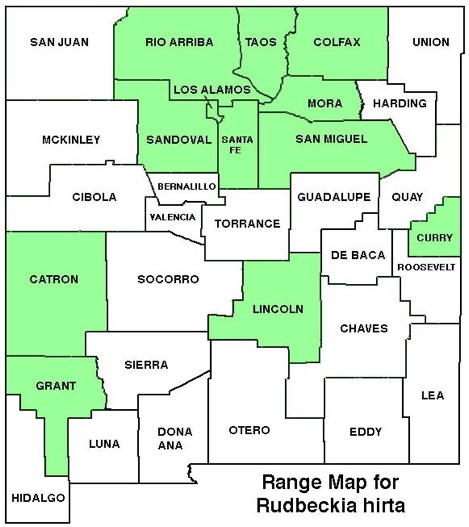WILDFLOWERS OF NEW MEXICO

This 1–3 1/2-feet tall flower can form a wave of flowers covering mountain meadows and fields. Note the rough, hairy leaves and showy yellow ray flowers surrounding a dark-brown, dome-shaped disk.
FLOWER: April–July. Flower heads bloom on 2–7 3/4-inch long (5–20 cm) hairy stems (peduncles); 8–13, spreading (not drooping), petal-like ray flowers reach 1-inch long (25 mm) with strong veins and slightly notched tips, and may have a reddish base. The dark-brown central disk, a 3/8–1 1/2-inch (8–38 mm) dome, forms “Susan’s” eye.
LEAVES: Basal and alternate on stem. Blades 2–4-inches long (5–10 cm), lance-shaped to oval; surfaces covered with stiff hairs, margins (edges) vary from entire to serrated.
HABITAT: Sandy, loamy soils, stream sides, mountain meadows, roadsides; ponderosa, aspen, mixed conifer forests.
ELEVATION: 6,800–10,800 feet.
RANGE: CO, NM, WY, and all states eastward.
SIMILAR SPECIES: Prairie Coneflower, Ratibida columnifera, statewide, has drooping rays and a tall cylindrical cone. Sunflowers, Helianthus species, don't have the domed, protruding disk.
NM COUNTIES: In moist mid- to high-elevation habitats of north-cent. and sw NM: Catron, Colfax, Curry, Grant, Lincoln, Los Alamos, Mora, Rio Arriba, San Miguel, Sandoval, Santa Fe, Taos.









BLACKEYED SUSAN
RUDBECKIA HIRTA
Aster Family, Asteraceae
Perennial, biennial herb









THE CONTENTS OF THIS WEBSITE ARE COPYRIGHTED AND CANNOT BE USED
WITHOUT PERMISSION OF GEORGE OXFORD MILLER












































Basal leaves lance-shaped, hairy.
Stem and leaves covered with stiff, spreading hairs.

















EMAIL ME







